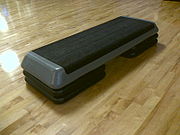
Step aerobics
Encyclopedia

Step aerobics
Aerobics
Aerobics is a form of physical exercise that combines rhythmic aerobic exercise with stretching and strength training routines with the goal of improving all elements of fitness...
is distinguished from other forms of aerobic exercise
Aerobic exercise
Aerobic exercise is physical exercise of relatively low intensity that depends primarily on the aerobic energy-generating process. Aerobic literally means "living in air", and refers to the use of oxygen to adequately meet energy demands during exercise via aerobic metabolism...
by its use of an elevated platform (the step). The height can be tailored to individual needs by inserting risers under the step. Step aerobics classes are offered at many gyms and fitness centers which have a group exercise program.
Step aerobics was innovated
Innovation
Innovation is the creation of better or more effective products, processes, technologies, or ideas that are accepted by markets, governments, and society...
by Gin Miller around 1989.
Step aerobics can also be involved in dancing games, such as Dance Dance Revolution or In the Groove.
Moves & Techniques
Often moves are referred to as ReebokReebok
Reebok International Limited, a subsidiary of the German sportswear company Adidas since 2005, is a producer of Athletic shoes, apparel, and accessories. The name comes from the Afrikaans spelling of rhebok, a type of African antelope or gazelle...
step moves in reference to one of the first makers of the plastic step commonly used in gyms.
The "basic" step involves stepping first one foot then the other on top of the step and then stepping the first foot and then the other back to the floor. A "right basic" would involve stepping right foot up, then the left, then returning to the floor alternating right then left.
Many instructors of step will switch immediately between different moves, for example between a right basic and a left basic without any intervening moves, forcing people to "tap" their foot instead of shifting weight. However, one form of step is called tap-free or smooth step in which feet always alternate without the ambiguous "taps" that can make learning step difficult for beginners. This requires a bit of foresight and planning by the instructor in order to insert a transitional or switching move that maintains the natural alternating weight shift akin to walking. For example, from a series of right basics one may insert a "knee up" (which involves stepping up and lifting the knee and returning the lifted leg to the ground, thereby switching feet) and then continuing to a left basic. However, this requires planning and the extra beats required for the transition move.
Common Moves include:
- Basic Step
- Corner knee
- Repeater knee
- T-Step
- Over-the-Top
- Lunges
- V-Step
- Straddle Down
- L-Step
- Split Step
- I-Step
Choreography
Many instructors will prepare a set of moves that will be executed together to form the choreography of the class. Usually, the choreography will be timed to 32 beats in a set, ideally switching legs so that the set can be repeated in a mirrored fashion. A set may consist of many different moves and the different moves may have different durations. For example, a basic step as described above takes 4 beats (for the 4 steps that the person takes). Similarly, the "knee up" move also takes 4 beats. Another common move, the repeater knee, is an 8-beat move.Classes vary in the level of choreography. Basic level classes will tend to have a series of relatively basic moves strung together into a sequence. More advanced classes incorporate dance elements such as turns, mambos, and stomps. These elements are put together into 2-3 routines in each class. One learns the routines during the class and then all are performed at the end of the class. Regardless of the complexity of the choreography, most instructors offer various options for different levels of intensity/dance ability while teaching the routines.
Benefits
Step aerobics helps burn calories. The number of calories burned depends on the speed of movements, step height, and length of exercise time. Step aerobics provides endurance training, which helps maintain the health of the cardiovascular system. The strength training component of step aerobics helps improve gait and balance. Step aerobics provides flexibility training that enhances joint movements. Step aerobics has a positive impact on mental health as well. Since the workout is fun and enjoyable, it can help release stress. If the workout is done in a group, the exercise session can create social connections with others. Lastly, step aerobics is suitable for all ages, low cost, and has no restrictions on place.External links
- Turnstep site with choreography and animations
- GinMiller site with more history and the beginning of Step
- Revised Step Reebok guidelines

